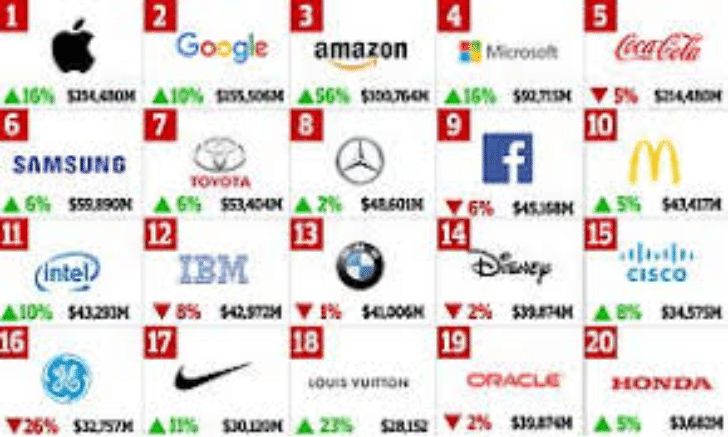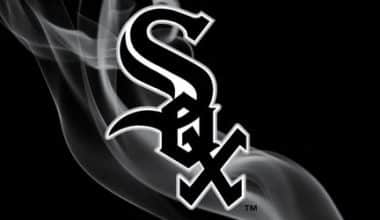The Lil Peep logo design is inspired by the tattoos that adorn the rapper’s body. Lil Peep was an outcast at school. He had drawings on his face and a pink mane to separate himself from a harsh culture. As a result, the rapper and musician began to preach transparency, honesty, and independence through his fashion style.
But because Lil Peep began releasing songs under the artist name “Trap Goose” early in his career, the current Lil Peep logo did not exist immediately. When he released his first mixtape, Lil Peep: Part One, in 2015, he changed his stage name to Lil Peep.
His new stage name had a nostalgic feel because his mother used to nickname him “Peep” when he was little. The artist’s name is written by hand on the piece of art, and the letter cases are hard to read. The letters I and E are lowercase, while “L” and “P” are uppercase.
Let’s go into more detail about the history of Lil Peep and its logo.
Lil Peep Logo: Overview
Lil Peep’s brief existence was filled with fame and exciting occurrences. It came to an end in 2017, only a few days after his 21st birthday. Gustav Elijah hr, the son of Harvard University alumni, dropped out of school to complete his degree through online courses and dedicate more attention to music.
Lil Peep made his first recordings at home and released them on streaming networks. You could argue that he grew up on the Internet because he was an outcast in real life. Gustav was happy and friendly in public, even though he was having trouble in school and his relationship with his father was tense. He was always willing to help, and others took advantage of this.
The artist enabled his buddies to live with him, even if it meant spending the night on the street. In reaction, they placed him on drugs in order to get closer to being a popular performer in this way. It is still unknown whether the last overdose was an accident or if Lil Peep was killed by administering a deadly dose and ignoring his deteriorating condition for five hours.
The songs he wrote only revealed his inner life to the schoolchildren’s idol. Almost all of the lyrics dealt with despair and drugs, and the style was a cross between hip-hop, rock, rap, and emo music. Lil Peep’s popularity peaked in 2016 when he released the Hellboy mixtape. The New York Times journalists then began to write about him, dedicating a separate story to Gustav Elijah’s personality and work.
Lil Peep Logo: History and Meaning
The rap artist’s logo is inspired by the tattoos that adorn his body. Peep had an amazing school appearance: he drew on his face and colored his hair pink to isolate himself from an unpleasant culture. After that, the songwriter got his own style and started to encourage people to be free, honest, and open.
The contemporary Lil Peep logo did not exist right away since Gustav was performing music under the alias Trap Goose at the time. With his debut mixtape, Part One, in 2015, he adopted a new stage name. This brings back memories of my mom calling him Peep as a child. A handwritten nickname appears in the artist’s graphic. Letter case is difficult to determine: I and “e” appear to be lowercase, while two “L” and both “P” appear to be uppercase. Except for “I” and the second “L,” all signs in words are interrelated in this example.
Lil Peep Logo Font and Colors
The most well-known Lil Peep cover is on the fourth Crybaby mixtape. It features a black-and-white image of a bird wrapped in a “Cry Baby” ribbon. The bird flies away, flailing its wings, tears streaming from its black eye. The title of the music album is written in a beautiful font with colorful designs. Above his right forehead, the rapper got a matching tattoo. He did it because he was a whiner as a child and considered himself a crybaby.
Symbol of Lil Peep Logo
The author’s fonts are utilized for inscriptions on both the main logo and the album’s symbol. Because Lil Peep was a creative individual, it is probable that he invented them. The musician’s moniker is “scratched,” referring to the uneven and careless lettering with many short lines. The name of the Crybaby mixtape stands out against the background since it is written in clean baroque handwriting. The color scheme is simple: black and white.
Lil Peep’s Life History
Gustav Elijah Ahr, better known as Lil Peep, was an American rapper, singer, and songwriter best known for his debut studio album “Come Over When You’re Sober.” The rapper was one of the top artists of the “post-emo revival” hip-hop and rock style.
His parents were both Harvard University graduates, but they divorced while Peep was a teenager. Naturally, this had a negative impact on Peep’s identity. So, he expressed himself through his songs and seemed to be a young man who was lonely and depressed.
Lil Peep began his music career at the age of 17 in Los Angeles. In 2015, he released his first mixtape, “Lil Peep: Part 1.” He put out his first album online because he couldn’t find a good record label.
One of his debut album’s songs, “Beamer Boy,” went on to become a blockbuster success, making Lil Peep famous all over America. After putting out different mixes, in 2017 he put out his first studio album, which was a commercial and critical success. Lil Peep, 21, died of a heroin overdose in November of the same year.
Early Years
Gustav Elijah Ahr, called Lil Peep, was born on November 1, 1996, in Allentown, Pennsylvania, to Karl Johan Ahr and Liza Wormack. He was raised in a comfortable middle-class environment, with both of his parents working as tutors. His mother was a first-grade teacher, while his father was a university professor. Karl “Oskar” Ahr was his brother.
However, Gustav’s parents’ education did not ensure him a trouble-free life. As a child, he saw his parents fight a lot, which had a big effect on his sense of who he was. Soon after Gustav was born, his family moved to Long Island, New York, which was a completely new setting for him. He found this transfer difficult to accept because he had already acquired social difficulties.
Gustav’s parents split when he was 14 years old. As a result, he became more introverted. He found it hard to talk to people face-to-face, so he preferred to talk to his friends online.
While he excelled academically, he loathed going to school due to his reclusive disposition. Despite this, he went to elementary school and then high school. Even though Gustav was rarely in class, he got good grades, and his teachers thought he was odd.
Gustav didn’t finish high school, so to get his diploma, he took a few online classes. He also completed a number of computer courses. Gustav was very interested in making a career out of music at this point, and he had already started putting his songs on SoundCloud and YouTube. Gustav moved to Los Angeles when he was 17 to become a musician, which was his dream.
Career
In Los Angeles, Gustav adopted the stage name “Lil Peep.” He had long admired underground acts such as rapper iLoveMakonnen and the band Seshhollowwaterboyz. Lil Peep went bankrupt within months of moving to Los Angeles and spent several nights on the streets.
When Lil Peep lived in New York, he had a large social media following, which he began meeting in person as soon as he moved to Los Angeles. When he got in touch with a few rappers, including Craig Xen and Ghostemane, as well as a music producer named JGRXXN, things began to look better for him. He also spent the majority of his time at their residences. Lil Peep later joined the group “Schemaposse” a few months later.
Lil Peep released his debut mixtape, “Lil Peep: Part 1,” on SoundCloud in 2015 with the support of his new music group. The album did not receive the response he had hoped for, with only 4,000 plays in the first week of its release. However, it steadily gained traction as more individuals warmed up to it.
Soon after releasing his debut mixtape, he released an EP titled “Feelz,” as well as another mixtape titled “Live Forever.” He didn’t become well-known right away because his music was so different and didn’t fit into any one genre. Trap music, dream pop, and punk rock were all influences on his music. Most critics and listeners didn’t like the lyrics, which were dismal but highly expressive.
Read Also: MONSTER LOGO: Meaning, Origin, and What You Should Know
Eventually, “Star Shopping,” a single from Lil Peep’s debut mixtape, became a tremendous success. It was also a surprise success in the underground hip-hop scene. Lil Peep, on the other hand, had major popular success after releasing the smash tune “Beamer Boy.” Because the song was so popular, the rapper and Schemaposse started their first tour in Tucson, Arizona.
When other Schemaposse rappers rose to prominence and wealth, the trio disbanded. They remained friends, however, and occasionally collaborated on one another’s subsequent projects. Lil Peep later joined another rap group called “GothBoiClique.” In 2016, he released his debut full-length album, “Crybaby,” with the group.
This was the year Lil Peep achieved actual mainstream success. He gained even more notoriety after releasing another mixtape dubbed “Hellboy.” His songs were uploaded on SoundCloud and YouTube, where they received millions of plays and views. “Girls” and “OMFG,” two tunes from “Hellboy,” became hugely successful.
Read Also: YALE LOGO: Meaning, Rate, History, and Tuition
Lil Peep was involved in a minor controversy when he was accused of stealing lyrics from the band “Mineral” for his song “Hollywood Dreaming.” But he defended himself, saying it was his way of paying honor to Mineral and their music.
On August 15, 2017, Lil Peep released his debut studio album, “Come Over When You’re Sober.” The album debuted at #168 on the Billboard 200. The album reached at number 38, and the rapper launched a tour to promote it. However, Lil Peep tragically died in the middle of this tour on November 15, 2017.
Many of his unreleased tracks were made public after his death, including classics like “Falling Down,” “Awful Things,” “Spotlight,” “4 Gold Chains,” and “Spotlight.” After his death, Columbia Records purchased the rights to his songs.
Musical Style
Lil Peep was described as an “emo rapper” and an “emo-trap heartthrob” who made lo-fi rap. Music critics frequently compared Lil Peep to guitarist and singer-songwriter Kurt Cobain. According to New York Times music critic Jon Caramanica, Lil Peep was the Kurt Cobain of lo-fi rap, thanks to his dark and devilishly lyrical songs.
Lil Peep, for his part, pushed the link and personality in his lyrical and musical material, indicating he aspired to be like Kurt Cobain.
According to AllMusic, Lil Peep’s music was influenced by rock and hip-hop, as well as dream pop, punk, and trap music. His tracks were influenced by the triple-time hi-hats of southern rap as well as the angsty soul-searching of post-hardcore. Lil Peep infused rap music with elements of pop-punk and emo, providing a fresh take on the genre. As a result, Pitchfork’s Steven J. Horowitz dubbed him the “future of emo.”
Lil Peep rose to prominence as a rising artist in the field of alternative hip-hop, carving out his own platform to speak to fans about a variety of concerns, including mental health. His songs were about drug use, sadness, suicidal thoughts, and past relationships, and he mixed hip-hop and trap music with alternative rock, third-wave emo, dream pop, and pop-punk.
A close friend who helped make “Come Over When You Are Sober” says that Lil Peep wants to speak up for people with depression and anxiety, people who have been bullied or abused, and people who, like him, have been misunderstood. Lil Peep had his own troubles, which he dealt with through music.
Death and Personal Life
Lil Peep had indicated on numerous occasions that he had a tough upbringing and had been a loner his entire life. He was depressed most of the time, which is why he had the word “Crybaby” permanently engraved on his face. Even after overcoming adversity and becoming renowned, he couldn’t shake his depression and frequently sung about it in his music.
Lil Peep was discovered dead in their tour van by his manager on November 15th, 2017. He was supposed to perform in Tucson, Arizona. He’d experimented with cocaine, marijuana, and a variety of other narcotics.
He’d gone into the bus to slumber around 5 p.m. on the day he died. His boss woke him up twice and assured him that he was breathing normally. When the manager tried to rouse Lil Peep up for the third time, he discovered he’d stopped breathing. Lil Peep was confirmed dead of a heroin overdose after a comprehensive examination.
He was dating Instagram beauty, Arzaylea Rodriguez, at the time of his death.
In Conclusion,
Gustav Elijah Ahr (November 1, 1996 – November 15, 2017) was an American songwriter, rapper, singer, and model. Even though Gustav’s parents were both Harvard graduates and got a divorce when he was 14, he used working-class sounds in his songs.
He was a member of the GothBoiClique emo-rap group. Lil Peep is regarded as the godfather of emo-rap circles in the mid-to-late 2010s and has helped build an emo revival version of rock and rap music that inspired adolescent subcultures and outcasts.
Lil Peep, who was born in Allentown, PA, and raised on Long Island, NY, began releasing songs on SoundCloud in 2014 under the stage name Lil Peep since his mother had always called him “Peep.”
Peep quickly rose to prominence on SoundCloud thanks to his mixtapes Lil Peep: Part I, Live Forever, Crybaby, and Hellboy, as well as his duets with Lil Tracy. Indeed, Hellboy’s enormous success prompted him to announce his first solo tour throughout America.
Lil Peep’s music often talked about his problems with drugs, bipolar disorder, and depression. A week after he turned 21, Lil Peep died when he accidentally took too much Xanax and Fentanyl before a show in Tucson, Arizona.
Related Articles
- JUICE WRLD LOGO: Facts About Juice WRLD, The Rapper
- THE BEST 2022 BUSINESS MUSIC SYSTEMS (Updated)
- MUSIC MARKETING: Top 10 Strategies for Better Music Marketing
- APPLE MUSIC LOGO: History, Evolution & All You Should Know






